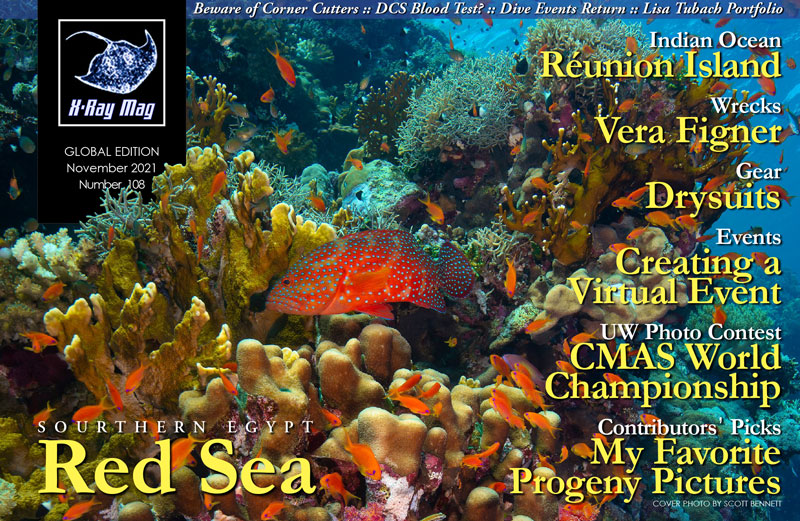We asked our contributors what their favorite images of broods and juveniles were, and they sent us photos and stories about the offspring and parenting behaviors of a variety of marine species. From a manatee mother and her calf to baby sea turtles to juvenile sharks, brooding Garibaldi fish to mantis shrimp protecting its eggs, a baby humpback whale to a rare nudibranch with a ribbon of eggs, X-Ray Mag contributors share their favorite images from near and far.
Contributed by
(To see all photos, please scroll down and download the full article PDF.)
Manatee Calf with its Mother, Crystal River, Florida, USA
Text and photos by Don Silcock
My favourite images of juvenile underwater creatures are those involving mammals. Their parent-child relationship is so much more intimate than with fish or reptiles, and my all-time personal picks would be from my trips to Crystal River in Florida to photograph the Florida manatees.
The Florida manatee is very much a protected species, and Crystal River is the only place in the United States where one is allowed to be in the water with them. There is a great deal not to like about the whole “swim-with-the-manatee” industry, and on busy days, it is just awful. However, on quiet days or early mornings, it can be incredible. It is particularly so, if you are patient enough to learn how to read the manatee’s behaviour patterns, and follow the rules on how you interact with them.
The very best spot in Crystal River to do that is in Three Sisters Spring where, if you are there when it is quiet, the visibility can be astounding. Often it will be individual manatees that venture into Three Sisters Spring; but if you are really lucky, there will be a mother and her calf, and that is when you can observe the incredible bond between them. To read more about these wonderful creatures, please go to my complete Guide to the Crystal River Manatees.
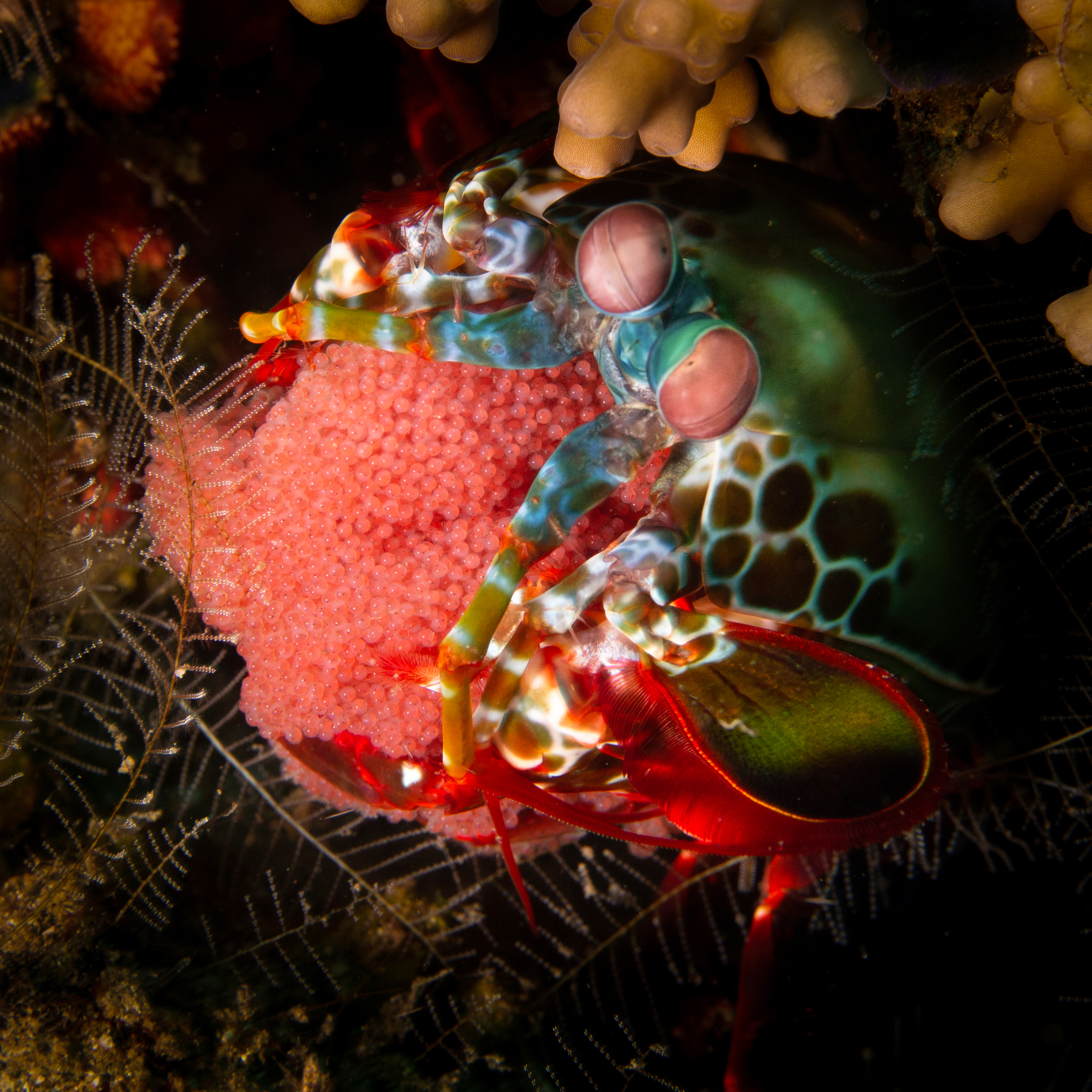
Humpback Calf, Sea Lion Pups, Mantis Shrimp & Jawfish Broods
Text and photos by John A. Ares
A humpback whale will bear a whopping 15-foot calf. However, photographing the calf is relatively easy. It must surface for air every five minutes or so. All you need to do is line up with the nose of the calf, and when it surfaces, you will be in position to see it up close. This black-and-white image of a humpback calf with its mother was taken with a film camera at Silver Banks in the Dominican Republic.
At just six feet in depth, Los Islotes at La Paz in Mexico is probably the world’s best shallow dive. Here, sea lion pups cavort with divers and live for play. Five pups are seen in the photograph. They were about seven months old in October and were big enough for the adults to leave them unsupervised for a short time.
Mantis shrimp eggs average 40 days to hatch. For this type of image, you need to work closely with dive guides and tell them what you want. I consider this shot, taken at Dumaguette in the Philippines, a “personal best.”
Jawfish are mouth-breeders. The father takes on the role of incubating and aerating the eggs. Eggs take seven to nine days to hatch. This image was captured at La Paz in Mexico. Visit: johnaresphotographic.com
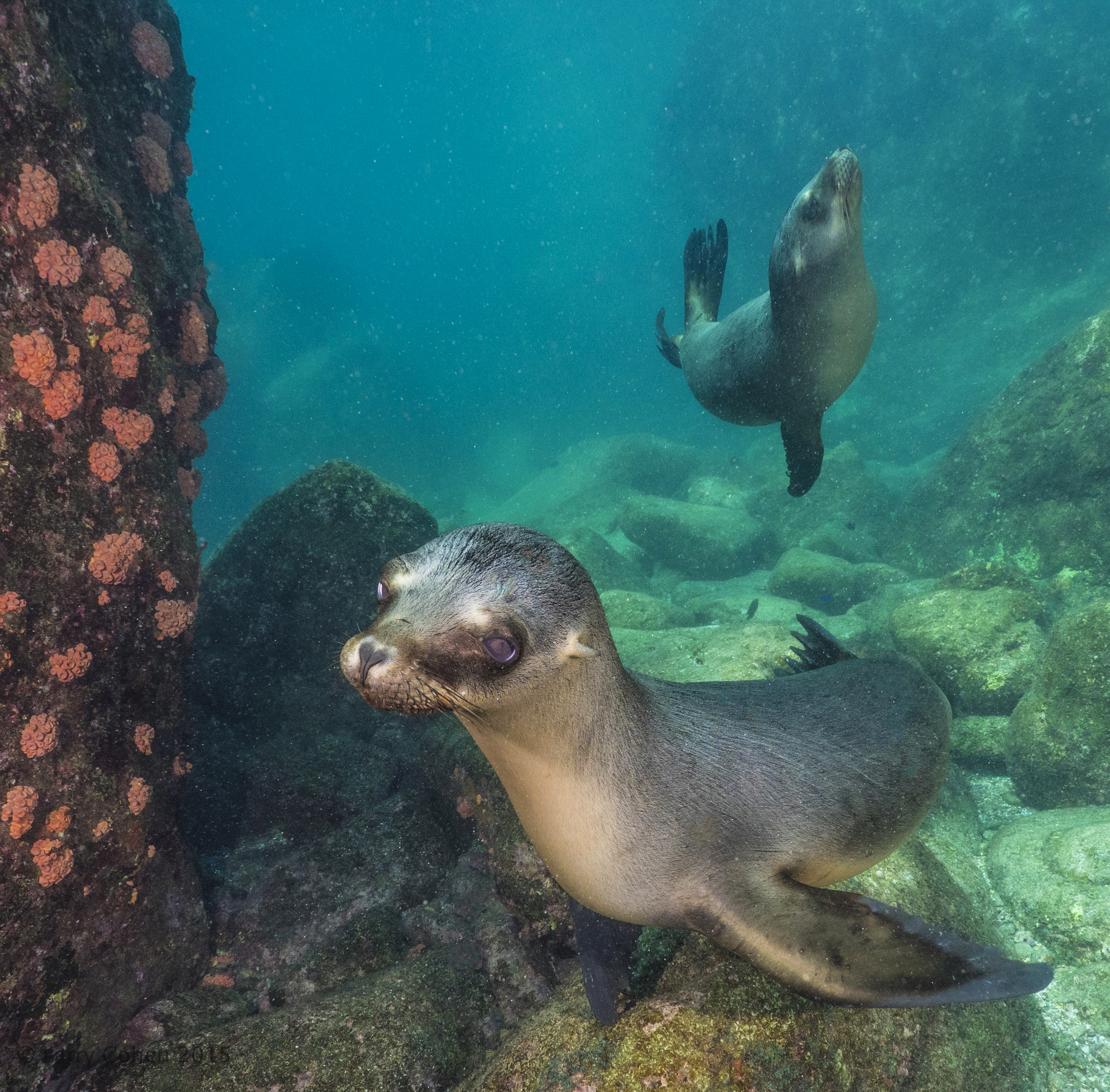
Sea Lion Pups, Isla Espíritu Santo, La Paz, Mexico
Text and photos by Larry Cohen
Diving with sea lions, especially pups, is an awe-inspiring experience. It is like playing with a litter of puppy dogs! One of the best locations is Isla Espíritu Santo, a two-hour boat ride from La Paz, Mexico. There is a large sea lion colony to the north of the island. Here, you can experience the antics of adults and pups from just under the surface to about 60ft (18.29m).
Sea lion pups are unafraid of divers, and it is not unusual for them to come over and look you in the face. The juveniles compete with each other for attention. It was heartwarming to see the way the youngsters affectionately played with their mothers.
I had my dome port cover stored on my arm while I was taking photographs. I thought I had lost the cover when I saw two sea lion pups having a great time tossing the cap from one to the other. So I grabbed my dome cover back, and the sea lions looked me in the eye and swam away. Visit: liquidimagesuw.com

Spiny Chromis, Ringed Pipefish, Anemonefish & Cardinalfish
Text and photos by Anita George-Ares
The spiny chromis guarding their young captivated me during several dives in North Sulawesi, Indonesia. Spiny chromis are unusual among fish in that the parents care for both their eggs and their juveniles. Unlike most fish species, the spiny chromis young do not have a pelagic (open water) stage. The adults aerate the eggs and chase potential predators away from the eggs and juveniles. The young feed upon the mucous produced on their parents’ skin.
I attempted to photograph adults with juveniles of different sizes and ages. This proved to be challenging, as it was difficult to focus on the constantly moving young. Spiny chromis have several color variations. The dark variation is common in Indonesia.
While diving off Dumaguete in the Philippines, it is not unusual to find a pair of ringed pipefish under a coral ledge. Like the female seahorse, the female pipefish transfers her eggs into the male’s brood pouch. The brood pouch provides nutrients and oxygen for the developing eggs. Depending on the pipefish species, the eggs hatch in about two to four weeks.
The anemonefish male assumes the responsibility of aerating and guarding the eggs until they hatch. Compared to pipefish, anemonefish eggs hatch relatively quickly—within six to ten days.
The Maaya Thila dive site in the Maldives has beautiful stands of black coral. After photographing a hawksbill sea turtle foraging among the black coral, I investigated another stand of black coral where I found this school of juvenile cardinalfish. Please visit my Facebook Page at: facebook.com/profile.php?id=100016947967639
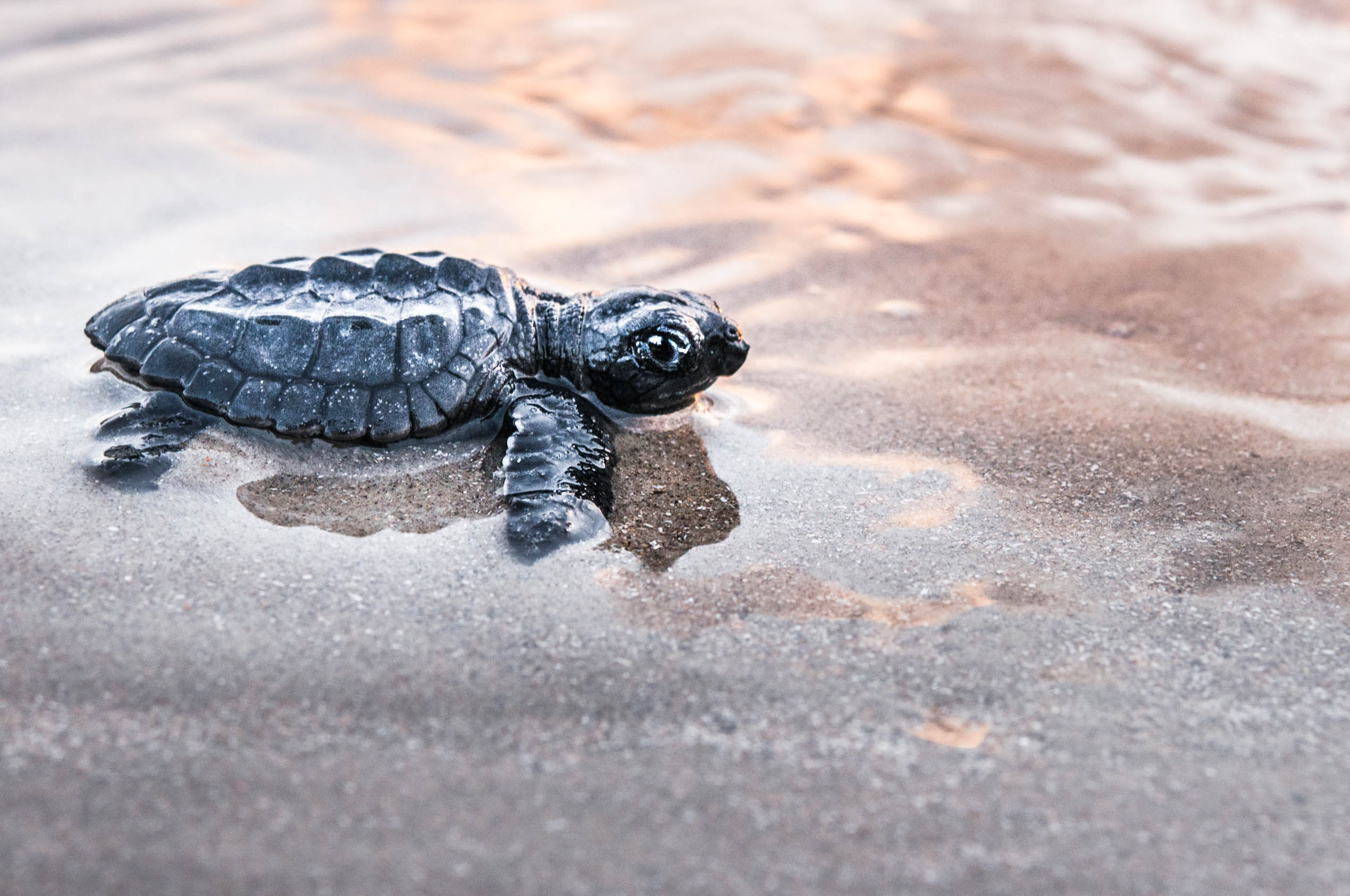
A Hatchling’s Life
Text and photos by Jennifer Idol
Aquatic life is weird. Sometimes adults do not look like their offspring, while other times, juveniles look like miniature replicas of their parents—even at the macro level. Regardless of the species, the young capture our hearts as we wonder how something so fragile could ever make it in their hostile environments. Of all juveniles, the sea turtle growth story is the most compelling for me.
The young are as small as an Oreo cookie, with fragile flippers and an enormous journey ahead. They begin life fighting to emerge from the sand for their first breaths before heading to the sea. Their journey across the sand is a gauntlet, escaping predators as they race to find cover and food in the open ocean.
I have photographed the largest of sea turtle hatchlings—the leatherback—and the smallest—the Olive Ridley sea turtle. Both emerge from nests buried in the sand and are subject to numerous dangers, including our footsteps with the potential to crush or to pack sand. As few as one in 1,125 of these tiny replicas will grow to become adults and return to their beaches roughly 15 years later to lay their own nests.
In Texas, North Padre Island National Seashore works to protect as many hatchlings as possible and give them a head start through their incubation program, which significantly increases their survival rate. Sandy Bay National Recreation Area in St. Croix protects nests by closing beaches during nesting season. Both efforts help these slow-growing, long-lived sea turtles. Visit: uwDesigner.com
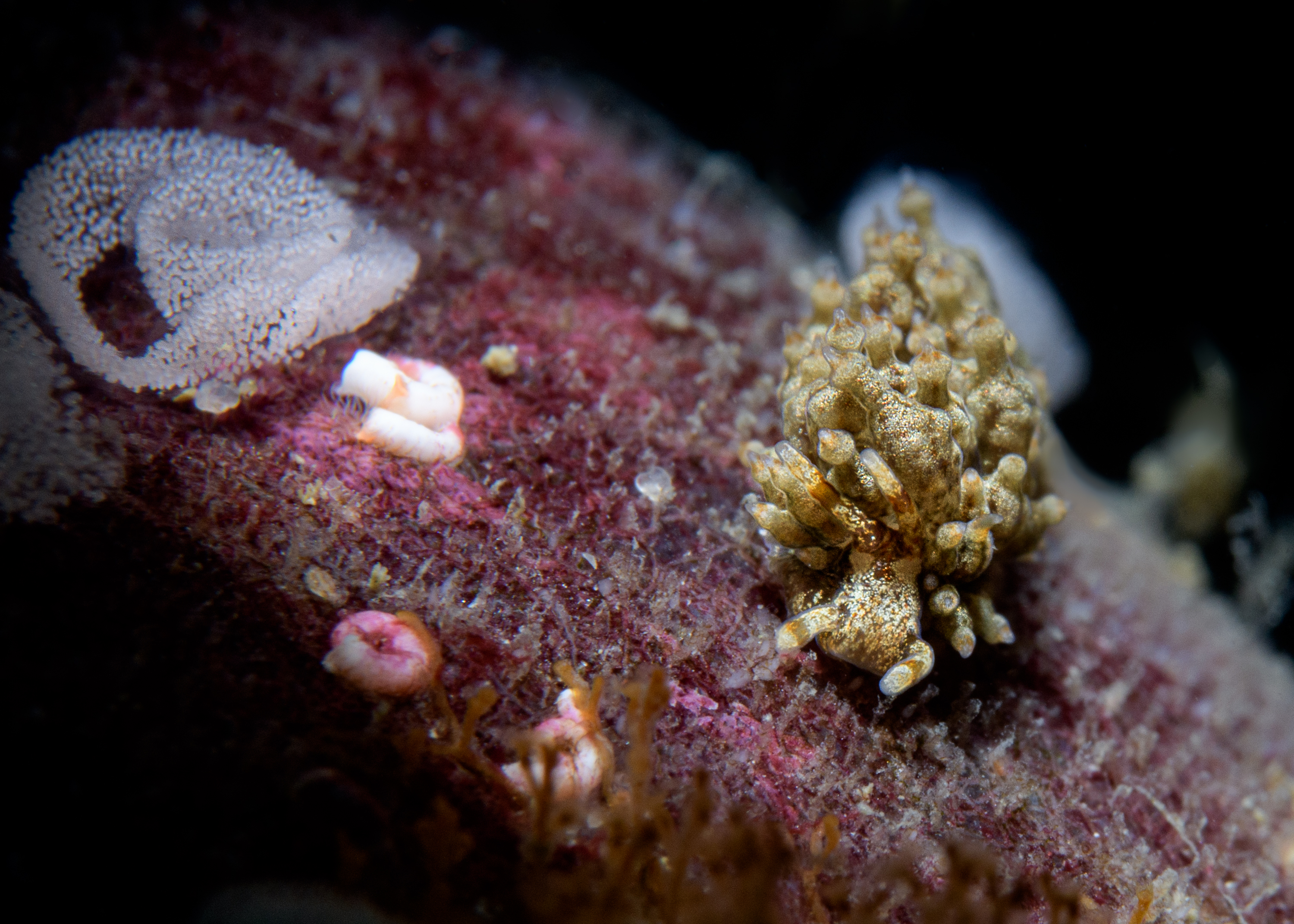
Rare Nudibranch's Egg Ribbons
Text and photos by Kate Jonker
When searching for nudibranchs, it is often easier to spot them if you know what their egg ribbon looks like. If you can find the egg ribbon, you usually find the nudibranch. This is because most egg ribbons are white, or a light colour and easier to find than their (often) well-camouflaged parents.
A while back, I noticed an abundance of small, white, whorl-like egg ribbons on much of the red bait (Pyura stolonifera) at Sterretjies Reef in Gordon’s Bay (near Cape Town, South Africa). But search as I might, I could not find the parents. Assuming they were well-camouflaged, I searched—but to no avail.
Six months went by, and the eggs slowly disappeared. Perhaps they had hatched and were already well-camouflaged parents themselves.
Recently, I noticed that egg ribbons had started to reappear. However, the surge was huge, and staying in one spot without damaging the reef was challenging. Eventually, in a moment of calm, I was able to search the red bait for the parents. And lo and behold, they were home! I waited patiently, flying five metres one way and five metres back, until the next patch of calm arrived and I was able to photograph the 5mm-long brown-coloured nudibranchs.
After downloading my photos, I was excited to discover they were candelabra nudibranchs (Eubranchus sp.) which are rare and endemic to False Bay. The moral of the story: Rely on the offspring, be patient, and they will eventually lead you to their parents! Visit: katejonker.com
California Sea Lion Pup with Mum
Text and photos by Celia Kujala
The California sea lion rookery of Los Islotes in Baja California Sur, Mexico, is the southernmost rookery of the species. It is a wonderful place to dive with sea lions because of the warm, beautiful blue water that one finds there during certain parts of the year. It was on one of my trips to the rookery in October that I had one of the most special experiences underwater.
During that time of year, sea lion pups are growing up fast, but they are still young and dependent on their mothers. I have had the chance to observe many mom-and-pup interactions on land, but this was the first time I had the opportunity to observe the intimate bond of the mom and pup underwater. When the cuddles got to be too much, the pup did not hesitate to give her mom a playful bite. Later in that dive, I saw a mom-and-pup pair dance in the sunbeams in what appeared to be a beautifully choreographed dance. The sunbeams were shining on them like a spotlight. It was the same area I had seen the pair earlier, and I will always wonder if it was them. Visit: sealpeace.com

Garibaldi Damselfish, California, USA
Text and photos by Matthew Meier
One of my favorite parenting behaviors to witness plays out in my own backyard. The Garibaldi (Hypsypops rubicundus) is the largest member of the damselfish family, growing up to 15 inches (38cm) in length, and has been granted protection from the fishing and aquarium trades as the official California state marine fish. It inhabits a range from Monterey Bay, California down to Baja California, Mexico and is easy to recognize with its uniformly vivid orange coloration. Juveniles appear similar to adults except for the numerous bright blue spots covering their bodies and fins.
Like all damselfish, the male tends to the eggs, which the female deposits on a section of bare rock prepared by the male within its territory. Fanning the eggs with its fins and blowing water over them with its mouth, the male aerates the eggs, in a similar fashion to its smaller clownfish relatives. During the roughly three weeks it takes for the eggs to hatch, the male maintains a close watch over the nest and aggressively defends its vulnerable brood from any creature, large or small.
On several occasions, I have taken advantage of this predictable behavior by locating a pleasing composition near an active nest and patiently waiting until the Garibaldi swam into the frame before snapping a photo. If conditions and bottom times allowed, I would shoot the same scene over and over again, firing the shutter each time the Garibaldi swam over to investigate. Visit: MatthewMeierPhoto.com

Family Portraits
Text and photos by Brandi Mueller
The original underwater maternity shoot. Some of my favorite behaviors to see underwater are marine life caring for the next generation. In the strange world below, parental care is often quite different from what we are used to up on the surface, and I love it when critters pose for the camera, showing off their future offspring.
Nudibranchs, like the Costasiella sp. (also known as Shaun the Sheep nudibranch), lay their eggs in coils on a leaf of algae, and this Shaun in the photo seems to be proudly displaying its future baby nudibranchs. The yellowhead jawfish (and other jawfish species) are mouth-brooders that protect their eggs by holding them in their mouths, occasionally spitting them out to aerate and rotate them, keeping them healthy until they hatch.
Peacock mantis shrimp hold their eggs in their front appendages, and some species share the holding duties between mated pairs, passing them back and forth, or in some cases, dividing them in half for both to carry. Other fish, like the weedy seadragon and pipefish, carry eggs on their tails until they hatch and swim off, making their own way in the world. Visit: brandiunderwater.com
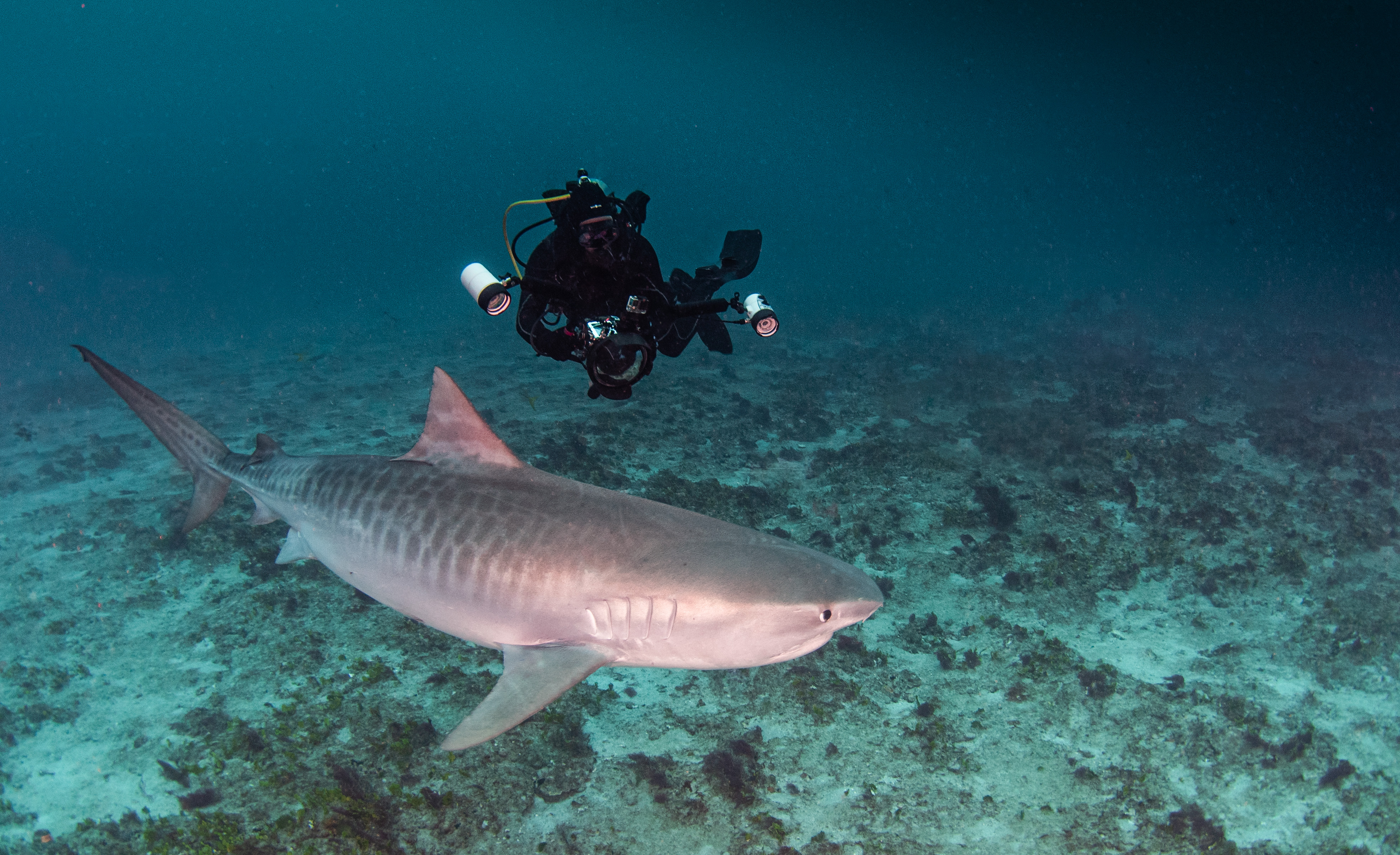
Summer’s Shark Juveniles
Text and photos by Gary Rose, MD
I particularly love the summer months of diving in Jupiter, Florida, USA. It is during these times of warm and calm seas that I have had some very wonderful introductions to juvenile sharks. It is not uncommon to dive with very young, one- to three-foot silky sharks, dusky sharks, sandbar sharks and occasional bull sharks. This past spring, I even had the amazing experience of diving with a juvenile female tiger shark.
Granted, young tiger sharks present on a much grander scale than most other young sharks. She swam by our group of divers, far on the periphery for a few weeks, and then finally came in close enough for her first photo shoot. She was gorgeous, shy, and about 4.5 feet long. I will tell you a little secret about her: She had been following Patrick, our rare male “adolescent” tiger shark. Just like with humans, juveniles become adolescents, adolescents become adults, and then… I will leave what comes next to your imagination.
The most enjoyable aspect of diving with juvenile sharks is that they are so playful and awkward—constantly bumping, prodding, and exploring—a real joy. They have no hesitation in swimming right up and bumping into a camera housing dome port, which becomes a fantastic photo op. They will also nip at strobes, strobe wires, arms and hands. Juveniles are juveniles, and they will stop at nothing to explore and learn about their new environment. Just when you think it could not get any better, it does. Each year brings new juvenile sharks. Visit: garyrosephotos.com
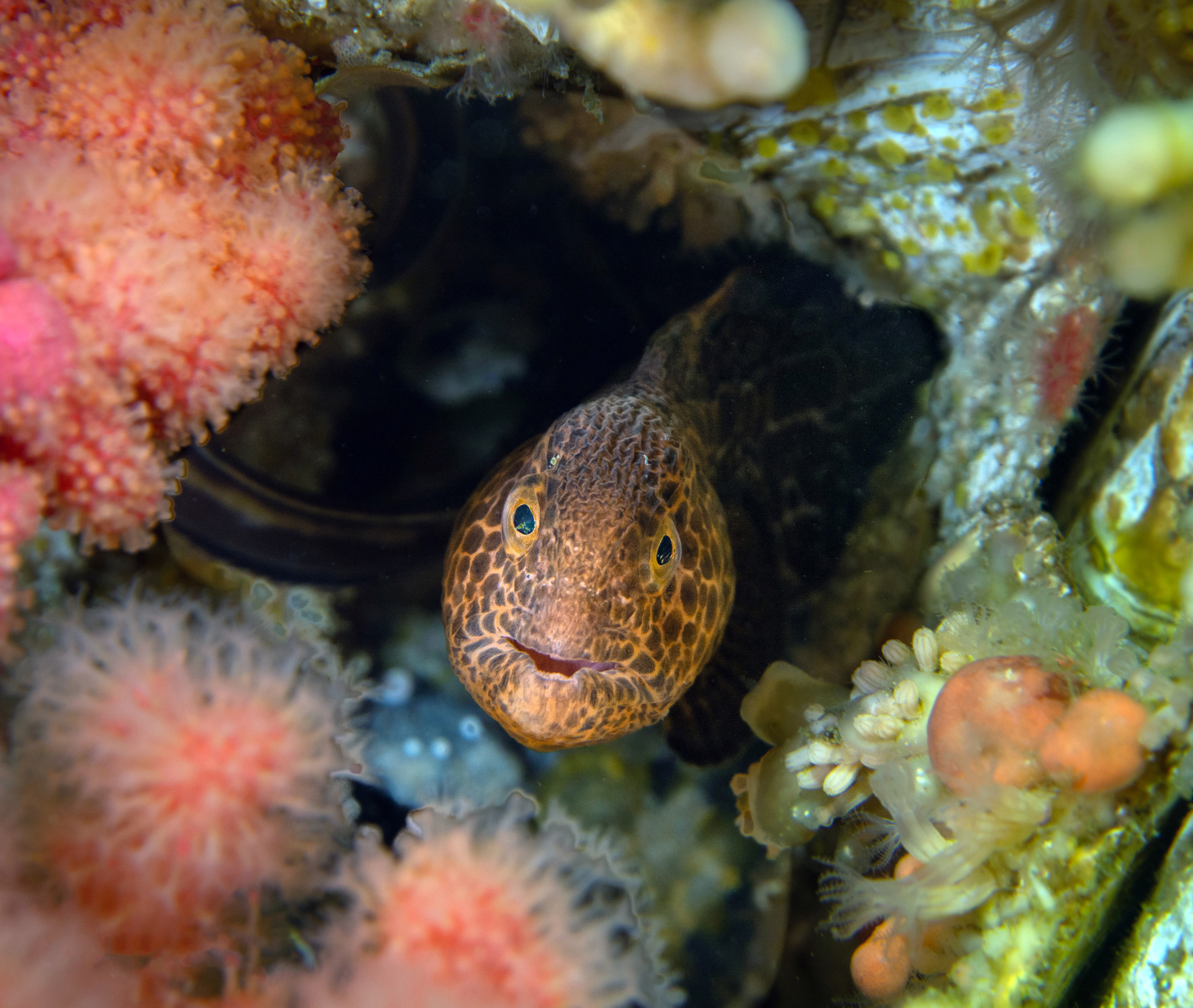
Juvenile Wolf Eel
Text and photos by Olga Torrey
From the first day I started scuba diving, I had always wanted to explore the cold waters of British Columbia in Canada. One of the reasons why I wanted to go there was to see and photograph a wolf eel. These gentle fish have a face that only a mother could love. They also have an easygoing personality and enjoy interacting with divers. Female wolf eels lay about 10,000 eggs, which take 13 to 16 weeks to mature and hatch (according to Wikipedia). What I did not realize is how different a juvenile looks from an adult wolf eel.
While exploring a wall, I saw a cute, tiny eel swimming freely above me. I followed the fish until the creature went into a small hole in the rocky reef wall. It was as curious about me as I was of it. The fish poked its head out of the hole and stared at me, as I stared at it. I captured an image of the eel with my Olympus 12-50mm lens, set to shoot in macro mode. Unfortunately, I had no idea what species this tiny eel was. After surfacing and returning to the Nautilus Swell liveaboard, I showed the image to the captain. I was surprised to learn that it was a juvenile wolf eel. I thought to myself, they certainly do not age well! Please visit: fitimage.nyc



